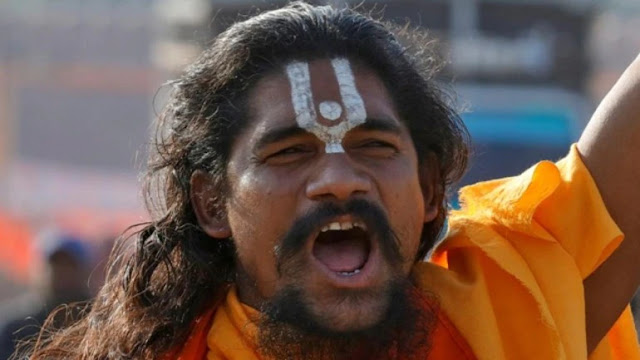RAM MANDIR case
RAM MANDIR ISSUE
Ramayana, a Hindu epic whose earliest portions date back to 1st millennium BCE, states that the location of Rama's birthplace is on the banks of the Sarayu river in Ayodhya. A section of Hindus claim that the exact site of Rama's birthplace is where the Babri Masjid once stood in the present-day Ayodhya, Uttar Pradesh.According to this theory, the Mughals demolished a Hindu shrine that marked the spot, and constructed a mosque in its place. The mosque was constructed during 1528-29 by Mir Baqi, a commander of the Mughal emperor Babur.
People opposed to this theory state that such claims arose only in the 18th century, and that there is no evidence for the spot being the birthplace of Rama.
The political, historical and socio-religious debate over the history and location of the Babri Mosque, and whether a previous temple was demolished or modified to create it, is known as the Ayodhya dispute.
In 1992, the demolition of Babri Masjid by Hindu nationalists triggered widespread Hindu-Muslim violence. Since then, the archaeological excavations have indicated the presence of a temple beneath the mosque rubble, but whether the structure was a Rama shrine (or a temple at all) remains disputed.
On February 8, 2018, the Supreme Court said that the politically sensitive case was purely a “land dispute” and will be dealt with in normal course.
On October 29, 2018, the hearing of the Ayodhya land dispute was postponed to January 2019. The hearing dates of the Ayodhya case will be fixed in January 2019.
 |
| https://upscaspirantindia1991.blogspot.com/ |
Ayodhya Ram Mandir-Babri Masjid dispute: The Hindu narrative
The Ram Mandir-Babri Masjid case of Ayodhya is a verdict away from its legal conclusion. Arguments spanning 40 days in the Supreme Court have been closed. The five judges of the Supreme Court led by Chief Justice of India Ranjan Gogoi will now apply their minds and pronounce their concurrent or divergent judgments.
Technically, tools of review and curative petitions by any of the affected parties will be available for exploration. But the decades-long litigation in Ayodhya Ram Mandir-Babri Masjid dispute will come to an end.
The complex legal matter has left many a bit confused as to what narrative was put forth by each side. IndiaToday.in will try to break both the narratives - by Hindu and the Muslim sides - into simpler points to make them more comprehensible for an average reader. In the first part of the series is the Hindu narrative of the Ayodhya Ram Mandir-Babri Masjid dispute.
The Hindu side - represented by seven parties - claimed title right over the disputed land in Ayodhya. The crux of their argument was that there was a temple dedicated to the birthplace of Lord Ram before Babri Masjid was erected during the medieval times.
The Hindu side rejects the claim that the Ayodhya site was disputed for very long. They argued that the Janmasthan (the place where Lord Ram is believed to have been born) came in dispute during Mughal period when a mosque was constructed at the spot.
However, the Hindu parties offer differing narratives of when the mosque was constructed. According to one view agreeing with the Muslims, the mosque was constructed by Mir Baqi. The other version claims that the mosque was constructed during the reign of Aurangzeb in the 17th century.
There is a third claim that there was no mosque at the Janmasthan till 1717. The supporters of this view refer to a map of the Janmasthan.
Circulated widely over social media platforms, this map is a sketch purportedly drawn in early 18th century when Sawai Jai Singh was a high-ranking noble in the Mughal darbar.
For record, Mughal emperor Aurangzeb died in 1707. It was Aurangzeb who had given Jai Singh II the title of Sawai in 1699 for his service as a Mughal vassal. Under later Mughals, Sawai Jaisingh broke free.
Sawai Jai Singh is said to have purchased the land surrounding the Janmasthan and got the map of the place drawn. This map is placed in the City Palace Museum of Jaipur - as part of the Kapad-Dwar collection.
The map shows three dome-like structures, which the Hindu side claims to be shikhar or spires of the temple dedicated to Lord Ram at the Janmasthan.
The map shows a courtyard that is labelled as Janmasthan and depicts a raised platform, purportedly the Ram Chabutra.
The Hindu side points to the central bay of three-dome structure which is labelled as Chhathi (that is, sixth) saying that the labeling denotes the Janmasthan. Chhathi also denotes to a traditional ritual - one of essential samskars (ceremony) in Hindu belief -- performed on the sixth day of a child's birth.
They claim that when mosque was constructed after the capture of the Janmasthan, the Hindus were prohibited from entering the spot marked as Chhathi.
Later, they built the Chabutara in front of the main structure and placed an idol of Lord Ram for worship. According to this version of Hindu story of Ram Janmabhoomi, the devotees performed pradakshinas (circumambulation) of the Chabutara.
This is the same idol that is said to have been placed by Hindus inside the Babri Mosque in 1949 when the matter flared up and led to a series of litigations culminating in the Supreme Court.
To prove their point, the Hindu side points to the other name of the Babri Masjid, that is, Masjid-e-Janmasthan. This series of arguments formed the basis for the Hindu parties led by Nirmohi Akhara to file title suit of the disputed land in Ayodhya.



0 comments:
Post a Comment